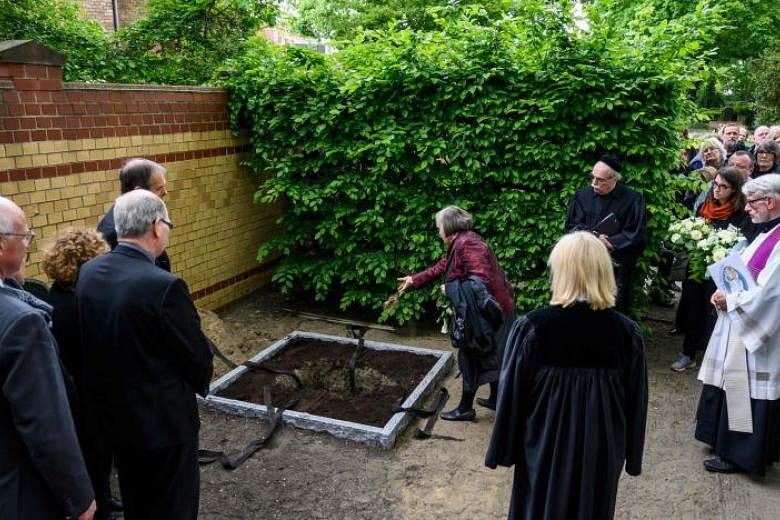BERLIN (AFP) - More than seven decades after World War II ended, more than 300 tiny pieces of human tissue from political prisoners executed by the Nazis were finally buried Monday (May 13) at a Berlin cemetery.
The samples - each a hundredth of a millimetre thin and about a square centimetre in size - were uncovered on microscopic glass plates by the descendants of the Third Reich anatomy professor Hermann Stieve.
Stieve dissected and researched the bodies of inmates killed at the Berlin Ploetzensee jail, including those of executed resistance fighters - in part to examine the physical impact of fear experienced by women.
"With the burial of the microscopic specimens... we want to take a step toward giving the victims back their dignity," said Karl Max Einhaeupl, head of Berlin's university hospital Charite.
Descendents of the victims attended a multi-religious ceremony, before the remains were finally laid to rest at Berlin's Dorotheenstadt cemetery.
The burial site had been picked as there are many graves and memorials for Nazi victims there, said Johannes Tuchel, director of the German Resistance Memorial Centre, which organised the event with Charite.
Tuchel said the human tissue samples were among "the last remains of people who were victims of the Nazis' unjust justice system ... They were denied a grave at that time, and so today, a burial is a matter of course."
Saskia von Brockdorff, whose mother Erika von Brockdorff was murdered at Ploetzensee, told AFP the burial provided "good closure".
"Now I know where I can mourn my mother, because she was executed on May 13, 1943, and we always went to Ploetzensee (to mourn her). But that's not really a good place to remember her, at least not for my soul. I'm now glad I can come here," said the 81-year-old.
Noose and guillotine
More than 2,800 inmates of Berlin-Ploetzensee prison were put to the guillotine or hanged between 1933 and 1945. Most were then sent for dissection to the Berlin Institute of Anatomy.
Stieve was the institute's director from 1935 to 1952 and carried out controversial research on the female reproductive system.
Most of the 300 specimens found in Stieve's estate stemmed from women, says a plaque to commemorate them which will be laid over the grave. The plaque however does not list the names of individual victims at the request of relatives.
Andreas Winkelmann, who was tasked by Stieve's heirs to determine the origin of the histological samples, said it was unclear how many individuals' remains were included in the batch of specimens.
Some 20 specimens came with names, others only numbers.
The clues have however helped draw a firm link with the Ploetzensee victims.
Humiliating the victims
Crucially for the history books, the microscopic remains provided rare concrete proof that prisoners' bodies were sent for dissection.
Winkelmann said the Nazis had sent the bodies to Stieve for dissection "not because they wanted to back Stieve's research, but because it was a way to humiliate the victims once again".
"First, by sending them to anatomy - something that not everyone wants... and it was also a way to deny the victims a grave," Winkelmann, a professor at Brandenburg Medical School's Institute of Anatomy, told AFP.
Adolf Hitler's regime sought to dump the remains of executed prisoners in unmarked mass graves because it did not want sites where relatives could mourn the victims, and from where political demonstrations could ensue.
Among those executed at Ploetzensee were 42 resistance fighters from the Berlin group Red Orchestra, among them von Brockdorff's mother Erika.
Stieve is believed to have dissected at least 13 of 18 executed women belonging to the group.
He was never charged with a crime and continued his medical career after the war like many other scientists who collaborated with the Nazis.
Only the highest-ranking physicians under the Third Reich were prosecuted at Nuremberg in the so-called doctors' trial for grotesque human experimentation and mass murder under the "euthanasia" programme.

